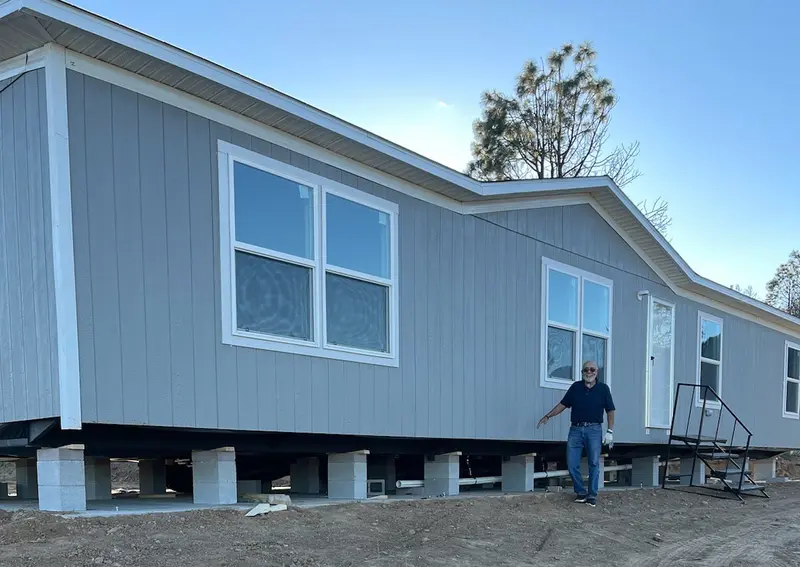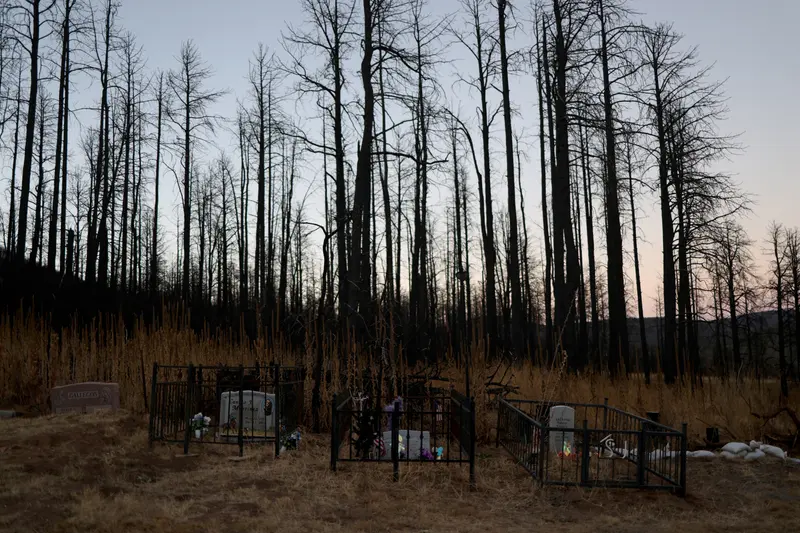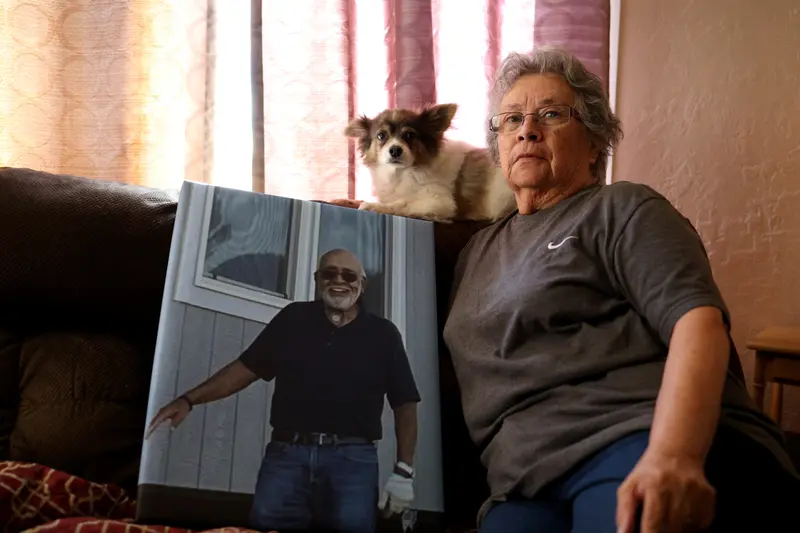This article was produced for ProPublica’s Local Reporting Network in partnership with Source New Mexico. Sign up for Dispatches to get stories like this one as soon as they are published.
Donato Sena and his wife, Maria Luisa, spent a recent afternoon loading furniture into the new mobile home placed on their land in Rociada, one of the areas hit hardest by New Mexico’s massive wildfire last spring.
The task was tiring for the couple, both in their 70s, and came after months of struggle to rebuild a semblance of their former lives stolen by the Hermits Peak-Calf Canyon Fire. They’d fought with contractors, bureaucrats, lawyers and sometimes each other as stress mounted and time stretched on.
That afternoon, however, Sena was happy.
“Finally, things are coming around,” Sena told his wife as they drove back to the house in Las Vegas, New Mexico, where they’ve lived since the fire. Even though their bills were mounting and their home was far from ready, maybe they’d get to spend a night there by Christmas, they told each other.
That night, Sena collapsed as he walked toward the front gate of their home since the fire, holding bags of groceries. He died. “I kind of knew he was already gone,” Maria Luisa Sena tearfully recalled of the moment she rushed to hold him on the sidewalk.
The cause of death hasn’t been determined, but his family believes a heart attack caused him to fall and hit his head. His wife and daughter, Nicole Sandoval, said in an interview that they believe the stress of trying to rebuild played a role.
“I strongly believe that, yes,” Maria Luisa Sena said. “Absolutely,” Sandoval added.
Like thousands of others from the area, Sena and his family are still awaiting payment from a $3.95 billion fund Congress established late last year to compensate victims of the wildfire, which was started by the U.S. Forest Service after it lost control of two prescribed burns.
Survivors of the fire told Source NM and ProPublica that the delays leave them in limbo. Many are desperate for compensation but unsure whether they can trust the Federal Emergency Management Agency after its initial disaster response last year. Few households received FEMA trailers while the agency was ramping up the claims office, and then it took too long to finalize regulations and begin to process claims, fire survivors said.
This summer, attorney Antonia Roybal-Mack convinced a federal judge to allow her to depose Sena and five other elderly or infirm clients, an effort to preserve their testimony should they die before getting paid or suing the federal government.
Sena’s death underscores the high stakes of delays in compensation and the tragedy befalling the aging, rural communities severed from the land they cherish. Some of them, like Sena, may never get to return to the land where their families lived for generations.
Data from the state Department of Health shows the two counties most affected by the disaster have been losing population for years, and local elected officials are concerned the slow recovery is accelerating that trend.
As of Nov. 30, FEMA, which is overseeing the compensation fund, had paid out $137 million, or about 3.5% of the total. Most of that has been paid in recent months, and frustration has grown among fire victims now waiting more than 18 months after the fire began for compensation.
Sena had submitted his claim more than five months ago. Roybal-Mack noted that the 74-year-old had been in precarious health as he waited for money to trickle out of the fund. He’d endured four bouts with cancer, most recently of the colon.
“Donato had one goal and that was to make it a single night in his new rebuilt home. I think what the government did here,” Roybal-Mack said, referring to the fire and the time it’s taken for FEMA to compensate people, “is unforgivable.” She is now pushing for payment on the claim.

In response to the attorney’s criticism, the FEMA office handling claims for fire victims offered its “deepest condolences” to Sena’s family and friends and said it would continue to work hard to compensate victims of the disaster.
Sena, whom family and friends call Frank, met his wife in high school in Las Vegas; they were married 54 years ago. The couple moved into their home in Rociada in 1991, about the time he retired as the police chief in nearby Las Vegas.
The couple fixed up the century-old adobe outbuilding they lived in and added rooms over the years. The home became the gathering place for their two children, four grandchildren and eight great-grandchildren.
On July 17, Sena sat for a deposition with his lawyers and those for FEMA. He recounted under oath seeing a massive plume of smoke through his picture window on April 25, 2022, and immediately fleeing his home with his wife and dogs. He later got a call from a sheriff’s deputy telling him his home had burned hours after they fled. “We were lucky to get out of there,” he said.
Sena also recounted his frustration with FEMA. He said that he appealed denials three times before being awarded $10,000 in FEMA disaster assistance, and that he had grown so distrustful of a separate federal disaster loan program that he decided to withdraw his application. Under cross-examination by Jordan Fried, a FEMA lawyer, Sena expressed his wish to return home as quickly as possible.
“My goal just this year is to get over there, and we want to live there. We want to move back,” he said, according to the deposition transcript. He wanted to get as much done as possible by the fall, he said, because winter would stall progress for months.
In an interview two weeks before his death, Sena told Source NM that he was exhausted after being repeatedly denied by FEMA and was running out of savings while he rebuilt without any financial assistance. The stress took a toll on his marriage, but he and his wife said they found a way never to go to bed angry.
“I think the only thing that saved us is we’ve been together forever. It’s not in our interest, no? Why would we want to leave each other over this?” he told Source NM. “But that’s how, that’s how bad it’s felt sometimes. I was a cop for 46 years, and let me tell you, this has been the worst, worst time in my life.”
With his cancer in the rearview mirror, he said, he was looking forward to finally coming home.
“Hopefully I can live to at least 85. That’s a long life,” he said after listing off his relatives who lived until their 80s or 90s. “I’m not ready to go yet.”
His death leaves his wife in charge of the logistics of recovery and the prospect of returning alone. She said she feels she owes it to her husband to move into the mobile home they bought with savings, turn on the lights and take in the views from their new picture window overlooking the Rociada valley.
They positioned the new home on their property to maintain the view, like they had before the fire.
“We angled it north and south so that we could have the view to the valley, because it was so beautiful,” Maria Luisa Sena said. “It is still beautiful.”
More than 100 people packed into the Our Lady of Sorrows Church on Nov. 13 for Sena’s funeral. He received an honor guard from his former police colleagues, and his coffin was draped with an American flag to honor his service in the Navy.
The family had decided not to bury him in the veterans cemetery in Santa Fe, alongside his parents and brothers. Instead, he was laid to rest in the Rociada cemetery, just a short walk from his old home.
The fire had blackened the cemetery’s soil, scorching trees and dumping ash on white gravestones. But Maria Luisa Sena said it’s the only place he could be at peace.
“It’s burnt. It’s all burnt. But he’s there. We took him back to Rociada,” she said, holding back tears. “Because he wanted to go back.”













